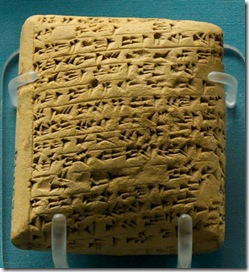Some months ago Eilat Mazar made a unique discovery in her excavations south of the Temple Mount. The find was kept under wraps until careful analysis could be conducted and the results published in the Israel Exploration Journal. The discovery is a fragment of a cuneiform tablet that likely dates to the 14th century BC. Duane Smith has a summary of the article. In part, he writes:
The tablet is so fragmentary that, other than a few general observations, no meaningful interpretation is possible. As Horowitz and Oshima say, “. . . it is clear that we know next to nothing about the original contents and circumstances of the letter. The main significance of this new find does not lie in what we can learn by reading the tablet, but in the historical and archaeological context of the tablet itself.”
He notes that there are a total of six lines, but no line has more than five readable signs. But this discovery is quite significant because of what it may tell us about Jerusalem at this time.
The tablet appears to be a copy of an “Amarna Letter,” sent by the king of Jerusalem (Abdi-Kheba?) to the Egyptian pharaoh Akhenaten living in Amarna (then known as Ahketaten). More than a century ago, nearly 400 of these texts were discovered in Egypt. They were initially thought to be forgeries because they are written in cuneiform and not hieroglyphics. But international correspondence of the day was in Akkadian and scholars soon agreed on their authenticity.
The Amarna Letters only give us one side of the story, because only the correspondence from Egypt’s neighbors is preserved. This new discovery suggests that more writings from this period could be discovered in Jerusalem. Lest you’re tantalized by the possibility that an archive may be a dig away, note that this tablet was discovered in Iron Age fill.
One interesting line of inquiry is a comparison of what we know about Jerusalem in the Late Bronze Age from archaeology versus what we know about Jerusalem at that time from textual sources. Hint: they don’t seem to match. I’ve been waiting for a book entitled The Amarna Letters Unearthed, but I’ve haven’t seen it yet.
Displayed in the British Museum
